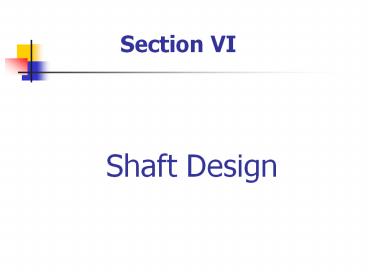Section VI Shaft Design * * Shaft? Shaft Design ASME Shaft - PowerPoint PPT Presentation
1 / 11
Title:
Section VI Shaft Design * * Shaft? Shaft Design ASME Shaft
Description:
Section VI Shaft Design * * Shaft? Shaft Design ASME Shaft Equations Design of Shaft for Torsional Rigidity Standard Sizes of Shafts Bending and Torsional Moments ... – PowerPoint PPT presentation
Number of Views:2726
Avg rating:3.0/5.0
Title: Section VI Shaft Design * * Shaft? Shaft Design ASME Shaft
1
Shaft Design
Section VI
2
Talking Points
- Shaft?
- Shaft Design
- ASME Shaft Equations
- Design of Shaft for Torsional Rigidity
- Standard Sizes of Shafts
- Bending and Torsional Moments
3
Shaft?
- Rotating machine element that transmits power.
- Shafts are usually circular in cross-section, and
may be either hollow or solid.
4
Shaft Design
- Consists of the determination of the correct
shaft diameter to ensure satisfactory strength
and rigidity when the shaft is transmitting power
under various operating and loading conditions.
- Design of shafts for ductile materials, based on
strength, is controlled by the maximum-shear
stress theory while shafts of brittle materials
would be designed on the basis of the
maximum-normal stress theory.
- Shafts are usually subjected to torsion, bending,
and axial loads.
1) For axial loads The tensile or compressive
stress is
2) For bending loads The bending stress
(tension or compression) is
3) For torsional loads The torsional stress
is
5
Shaft Design Cont.
6
Shaft Design Cont.
7
ASME Shaft Equations
- The ASME code equation for hollow shaft combines
torsion, bending, and axial loads by applying the
maximum-shear equation modified by introducing
shock, fatigue, and column factor as follows
- For solid shaft having little or no axial
loading, the equation is
Where
Where
8
ASME Shaft Equations Cont.
9
Design of Shaft for Torsional Rigidity
- It is based on the permissible angle of twist.
The amount of twist permissible depends on the
particular application, and varies about 0.3
degree/m for machine tool shafts to about 3.0
degree/m for line shafting.
Where
10
Standard Sizes of Shafts
- These sizes vary according to material
specifications and supplier. Typical sizes for
solid shafts are
- Up to 25 mm in 0.5 mm increments
- 25 to 50 mm in 1.0 mm increments
- 50 to 100 mm in 2.0 mm increments
- 100 to 200 mm in 5 mm increments
11
Bending and Torsional Moment
- These are the main factors influencing shaft
design. One of the first steps in shaft design is
to draw the bending moment diagram for the loaded
shaft or the combined bending moment diagram if
the loads acting on the shaft are in more than
one axial plane. From the bending moment diagram,
the points of critical bending stress can be
determined. The torsional moment acting on the
shaft can be determined from
1) For belt drive The torque is found by
2) For gear drive The torque is found by
Where
Where

